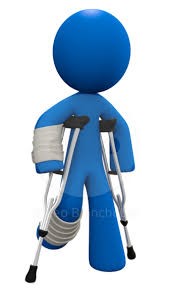By: Kimberly Daise
Most employers want to know how long an employee will be off work following an injury at the workplace. There are a lot of factors that go into the answer. It may include a review of the nature and extent of the injury, the employee’s age, the employee’s physical condition and the overall health.
The most common types of injuries are sprains and fractures. There are several factors to be considered when determining the time the employee will be off work. The first factor to consider is the type and extent of the injury. A moderate sprained ankle heals much quicker than a compound femur fracture. To get an idea of how extensive the medical provider considers a sprain, look for the adjective before the word sprain or strain.
The adjectives most commonly used with sprain and strains are:
- Slight – it happened and there is not much to it.
- Moderate – slightly extensive than slight – middle range pain
- Severe – more extensive than moderate – very painful
To understand how extensive a fracture is look for the medical assessment terms:
Most Fractures are described as follows:
- Simple: it has cracked and little bit of damage to the surrounding tissue
- Closed: basically, the same as a simple fracture
- Compound: the bone has broken in more than one spot, or the fracture has created significant tissue damage
- Open compound: the broken bone is exposed through a wound in the skin
- Compression: in the vertebrae where a brittle bone, due to age or osteoporosis, has cracked
Other terms used:
- Complete fracture: A fracture in which bone fragments separate completely.
- Incomplete fracture: A fracture in which the bone fragments are still partially joined.
- Linear fracture: A fracture that is parallel to the bone’s long axis.
- Transverse fracture: A fracture that is at a right angle to the bone’s long axis.
- Oblique fracture: A fracture that is diagonal to a bone’s long axis.
- Spiral fracture: A fracture where at least one part of the bone has been twisted.
- Comminuted fracture: A fracture in which the bone has broken into several pieces.
- Impacted fracture: A fracture caused when bone fragments are driven into each other.
Consider Age & Conditioning
In addition, the employee’s age may be a factor. A 25-year-old employee with a simple fracture will heal more quickly than a 55-year-old employee with the same injury.
The employee’s physical conditioning before the injury can play a significant factor in the employee’s disability recovery time. The 50-year-old employee who very active will recover from an injury faster than a 20-year-old employee who spends all his free time in front of a video monitor.
The overall state of an employee’s health will impact the disability time. For example: an employee with on-going medical issues such as obesity, diabetes, or other comorbidity issues will recover from an injury much slower than an employee who has the same injury, but no other on-going medical issues. Additionally, the non-smoker may recover from an injury faster than a smoker, all other factors being equal.
The total disability time range is the expected length of time before the medical provider will allow the employee to return to light duty work. The partial disability time range is the approximate amount of time the employee should be in a light duty job. It is important to review the injury assessment and consider the condition of the employee. Review both to get an idea of back to work time and possible conditions.

